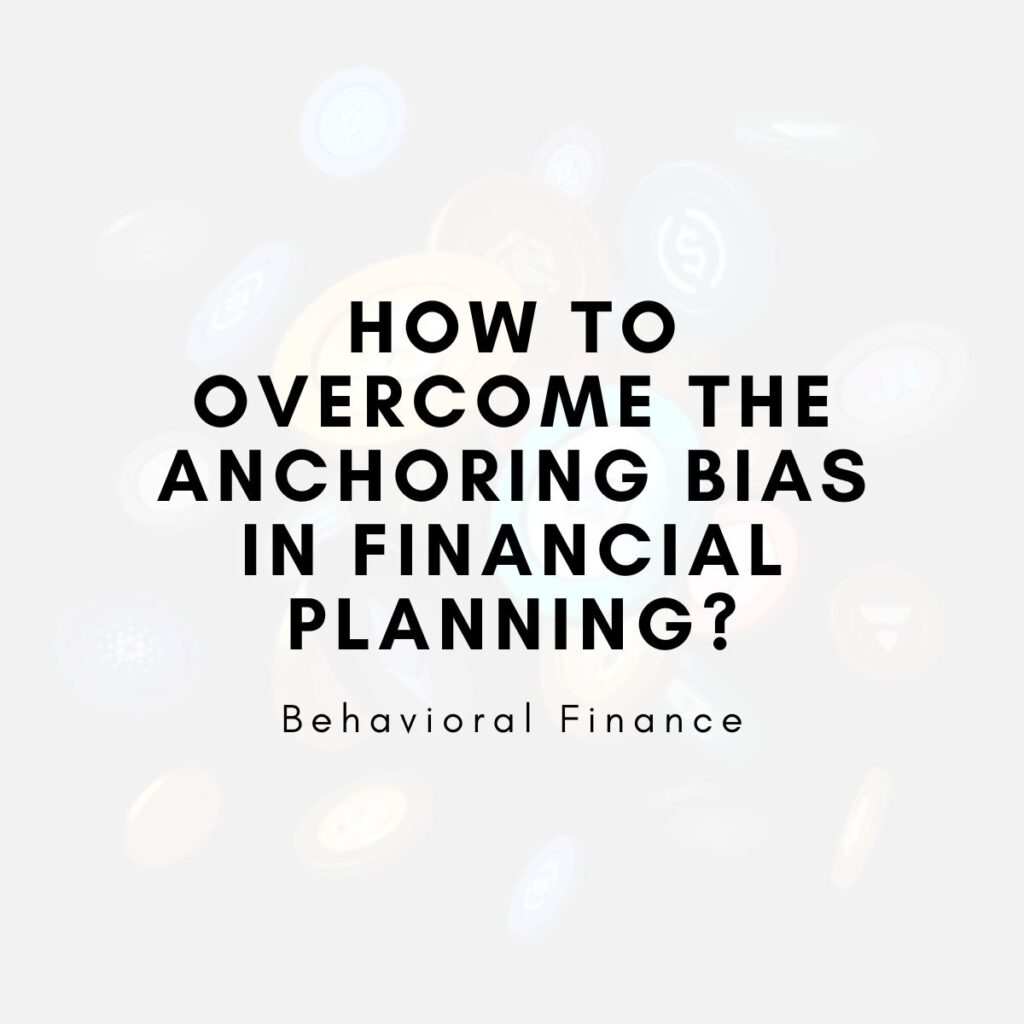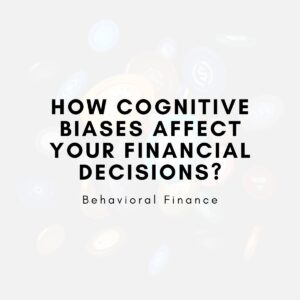
How can you overcome the anchoring bias in financial planning?
Anchoring bias —the tendency to rely too heavily on the first piece of information encountered— can severely affect financial decisions. This guide explains how anchoring works, its impact on your financial future, and practical strategies to help you avoid common pitfalls.
Summary Table: How to Overcome the Anchoring Bias in Financial Planning?
| Section | Summary | Key Tips | Examples |
|---|---|---|---|
| Understanding Anchoring Bias | Anchoring bias occurs when initial information influences decisions disproportionately, often leading to poor financial outcomes. | – Stay aware of anchoring tendencies. – Avoid relying solely on first impressions when making financial decisions. | Jack anchored to the purchase price of a stock and held onto it despite declining value, resulting in larger losses. |
| Impact on Long-Term Financial Goals | Anchoring can distort retirement and savings goals by tying them to outdated or irrelevant figures. | – Regularly reassess goals to reflect current circumstances. – Use dynamic planning tools. | Lisa anchored her retirement goal to her parents’ savings, but later adjusted for inflation and modern costs. |
| Strategies to Overcome Anchoring | Use self-awareness, regular reviews, and expert advice to mitigate anchoring bias in financial decisions. | – Seek professional advice. – Use data-driven financial tools. | Emily avoided anchoring bias by reviewing her portfolio regularly and consulting a financial advisor. |
| Overcoming Anchoring in Investing | Anchoring leads investors to cling to poor-performing assets due to their original price. Diversification and clear rules help avoid this bias. | – Diversify investments. – Set clear rules for selling or buying. | Ben set a rule to sell stocks after a 20% drop, helping him prevent bigger losses. |
| Avoiding Anchoring in Real Estate | Buyers often anchor to listing prices or initial offers. Comparing market data and seeking appraisals reduces this risk. | – Compare similar properties. – Get professional appraisals. | Mia saved $10,000 by negotiating after receiving an independent property appraisal. |
| Role of Emotional Intelligence | Emotional intelligence helps in pausing and analyzing decisions objectively, reducing the impact of cognitive biases like anchoring. | – Practice mindful decision-making. – Take a pause before big financial decisions. | Alex paused before accepting a job offer, researched salary ranges, and successfully negotiated a better deal. |
This table summarizes key sections of the post, including practical strategies, key tips, and real-life examples to help readers better understand how to overcome anchoring bias in financial planning.
Introduction
When it comes to financial planning, making rational decisions is crucial. However, human psychology often gets in the way. One common cognitive bias is anchoring bias, where an individual fixates on a specific number or value—often the first one presented—and allows it to disproportionately influence subsequent decisions.
For example, when negotiating the price of a home, the initial listing price can anchor your perception of what the home is worth, even if the actual market value is much lower. In financial planning, anchoring bias can lead to poor investment choices, unrealistic savings goals, and difficulty adjusting spending habits. This guide will explore how anchoring bias affects financial decisions and offer actionable steps to overcome it.
Understanding Anchoring Bias
Anchoring bias occurs when an individual relies too heavily on an initial piece of information (the anchor) when making decisions. This bias can be particularly damaging in financial planning, where initial values or expectations may no longer reflect reality.
How Anchoring Bias Manifests in Financial Planning?
- Investment Decisions: Investors may hold on to a stock because they’re anchored to its purchase price, even if the market indicates they should sell.
- Spending Behavior: People anchored to their initial income may fail to adjust their spending habits as their financial situation changes.
- Savings Goals: Setting unrealistic savings targets based on arbitrary figures rather than actual financial needs.
Example: Jack bought a stock at $100 per share. Even after it dropped to $70, he refused to sell because he was anchored to the original price, resulting in further losses.
How Anchoring Bias Affects Long-Term Financial Goals?
Anchoring bias can distort financial goals by tying them to irrelevant or outdated reference points. This can lead to unrealistic retirement savings targets or insufficient emergency funds.
Impact on Retirement Planning
Many people anchor their retirement savings goals to arbitrary figures, such as the amount their parents saved or an outdated financial benchmark. However, personal circumstances and inflation require a dynamic approach to goal setting.
Example: Lisa set a retirement goal based on her father’s savings but failed to consider that modern living costs and life expectancy had increased significantly.
Impact on Budgeting
Anchoring can also influence budgeting, with individuals sticking to old spending patterns despite income changes. This may result in over- or under-spending in key areas like housing or healthcare.
Example: Tom continued using his college budget long after he got a high-paying job, limiting his potential to invest and grow wealth.
Strategies to Overcome Anchoring Bias in Financial Planning
Overcoming anchoring bias requires active effort and self-awareness. Here are some strategies that can help:
1. Re-evaluate Your Financial Assumptions Regularly
Ensure that your financial plans are based on current data, not outdated assumptions. Review your budget, investments, and savings goals periodically.
Key Tip: Set a reminder to review your financial plan every quarter and adjust your goals as needed.
Example: Emily reviewed her investment portfolio every six months to ensure it aligned with current market trends and personal goals.
2. Seek Expert Advice
Working with a financial advisor can help you avoid anchoring bias by providing a fresh, objective perspective. Advisors can offer data-driven insights and help you make informed decisions.
Key Tip: Choose an advisor who understands your financial goals and uses evidence-based strategies.
Example: Ryan consulted a financial advisor when buying a house to avoid overpaying based on the listing price anchor.
3. Use Data-Driven Decision-Making
Rely on data rather than emotions when making financial decisions. This includes researching market trends, using online tools, and comparing multiple options before committing.
Key Tip: Use financial calculators and tools to base your decisions on solid numbers rather than gut feelings.
Example: Jessica used a mortgage comparison tool instead of anchoring to the first offer she received, saving thousands in interest.
Overcoming Anchoring Bias in Investing
In investing, anchoring bias can lead to holding onto poor-performing assets or failing to recognize new opportunities. To overcome this, it’s essential to stay informed and flexible.
1. Set Rules for When to Sell Investments
Avoid anchoring by establishing clear rules for when to sell investments. This could be based on percentage loss or gain rather than emotional attachment.
Example: Ben set a rule to sell stocks if they dropped by 20%, helping him avoid bigger losses.
2. Diversify Your Portfolio
Diversification reduces the impact of anchoring on any single investment. By spreading your investments across various assets, you minimize the risk of being anchored to a single poor decision.
Example: Sophia built a diversified portfolio with stocks, bonds, and real estate, reducing her reliance on any one asset’s performance.
How to Avoid Anchoring Bias in Real Estate?
Real estate is particularly prone to anchoring bias, as buyers often fixate on the asking price or initial offers. To avoid this, use market data to assess property values objectively.
1. Compare Similar Properties
Instead of anchoring to the first price you see, research comparable properties in the area to get a realistic idea of value.
Example: David compared three similar homes before making an offer, ensuring he didn’t overpay based on the initial listing price.
2. Get a Professional Appraisal
Hiring a professional appraiser can give you an unbiased estimate of a property’s value, helping you avoid overpaying.
Example: Mia hired an appraiser before finalizing her home purchase, saving $10,000 by negotiating down from the asking price.
The Role of Emotional Intelligence in Overcoming Anchoring Bias
Emotional intelligence plays a crucial role in overcoming cognitive biases like anchoring. By understanding your emotions and how they influence decisions, you can make more rational financial choices.
1. Pause Before Making Big Decisions
Take a step back and give yourself time to think before making significant financial commitments. This helps prevent impulsive decisions driven by initial anchors.
Example: After receiving an initial salary offer, Alex paused, researched market salaries, and negotiated a better deal.
2. Practice Mindful Decision-Making
Mindfulness can help you stay present and focused on the facts rather than being influenced by irrelevant anchors.
Example: Sophie practiced mindful decision-making when setting her savings goals, ensuring they were realistic and aligned with her current income.
Conclusion
Anchoring bias is a common cognitive pitfall that can significantly impact your financial planning. Whether you’re investing, buying a home, or setting financial goals, anchoring to irrelevant or outdated information can lead to poor decisions. By recognizing this bias and applying data-driven strategies, seeking professional advice, and regularly revisiting your financial assumptions, you can make more informed choices and achieve better financial outcomes.
Key Takeaways
- Anchoring bias can distort financial decisions, leading to poor investment, budgeting, and saving choices.
- Regularly re-evaluate your financial assumptions to ensure they align with current realities.
- Use data-driven tools and seek expert advice to minimize the impact of cognitive biases.
- Emotional intelligence and mindfulness can help you make more rational financial decisions.
- Diversification, clear investment rules, and professional appraisals can reduce anchoring bias in investing and real estate.




